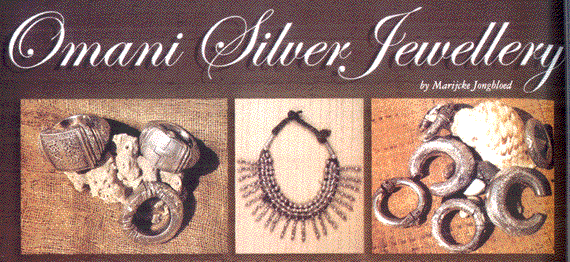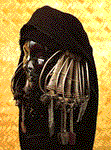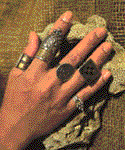 |
|
||||||||||||||||||||||||||||
 |
||||||||||||||||||||||||||||
|
|
Any
person who has once seen the Bedouin jewellery of this region cannot
help but become interested in its origin and history. One such person,
who lived in Oman for five years, is Oytun Camcigil. Although she
is an architect, trained in her homeland of Turkey, she has not practiced
this profession while her husband was stationed in various countries
in the Middle East. Instead she studied and collected the Omani silver
jewellery and then branched out into making fine pieces of jewellery
herself from both modern and ancient beads and silver pieces. Recently
she showed me her collection and I learned about their origin.
The Bedouin
preferred silver to gold for their jewellery, because silver was
thought to have protective powers. The head of a Bedouin Family
put his wealth in silver on the wrists, ankles and neck of his wife.
She felt appreciated by the jewellery bestowed on her, while he
had his wealth under his eye and hand if he needed it. The coastal
region of Oman has had contacts with the far corners of the world
since centuries due to the sea-trade that was conducted between
Oman and many other places such as Zanzibar, Yemen, Persia, Iraq,
Greece, Morocco, Egypt, and India. On the contrary, the interior of Oman was extremely isolated from the rest of the world for very long. It is therefore not surprising that the designs used on pieces of jewellery from Nizwa and Bahla are more primitive and unique than those on silver items from the coastal regions. What is surprising, however, is that these unique Omani designs are found also in Cyprus and early Roman Etruscia. They were brought there by the soldiers of the armies of Alexander the Great and his general Nearchos, who visited the region during their conquest of the Middle and Far East. Some
of the designs that are used are known throughout the Arab world
and are meaningful to the owners. Nizwa
in the interior of Oman has long been famous for the work of its
silver smiths. Both jewellery and the silver decorations for the
scabbard of the famous curved khanjar dagger were made here. The
latter is mostly decorated with geometrical and floral patterns,
and ideally has 7 rings, of which 2 are meant as belt holders. The
belt itself is also an intricate piece of work, made with silver
thread. Nizwa is famous for its geometrical designs and for the
heavy anklets (hajil) that are made here and in Rustaq. Other
towns also produced distinctive articles. Each had their different
designs and patterns. Nowadays,
few of the pieces that could be found in the suqs and antique shops
of Oman are the genuine article. Much of the real antiques have
already been scooped up by collectors. One such collection is held
by the Tarek Rajab Museum in Kuwait. Whether old or new, Omani silver jewellery is to be admired for the intricacy of the silver work and the originality of the designs.
|
|||||||||||||||||||||||||||
|
|
 |
 |
 |
|||||||||||||||||||||||||
|
|
Top | Home
| Al
Habtoor Group
| Metropolitan
Hotels
| Al
Habtoor Automobiles
| Copyright
© 2002 Al Habtoor Group. All
Rights Reserved.
|
||||||||||||||||||||||||||||